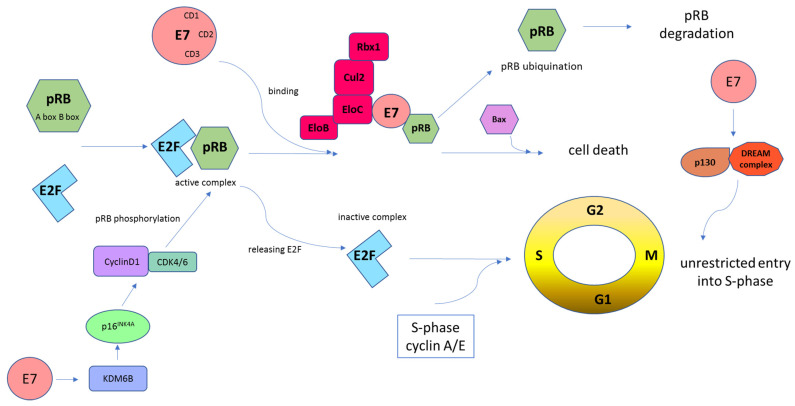Figure 5.
Schematic representation of E7-mediated retinoblastoma tumor suppressor protein (pRB) inhibition. Cells must pass the G1 restriction point, which is under the control of pRB, to progress from the G1 to the S cell cycle phase. E2F transcription factors are bound and repressed by pRB via the A and B boxes. Then, this complex binds the HR-HPV E7 protein. E7, through the CD2 and CD3 regions, binds to the B box of pRB via its LXCXE motif. Following these interactions, the pRB–E2F complex is disturbed, which leads to abnormal cell progression into the S-phase of the cell cycle. HPV E7-mediated pRB degradation can be mediated by the cullin 2 (Cul2) ubiquitin ligase complex. This interaction occurs via the E7 CR1 domain and the C-terminal sequences and drives cell cycle progression by degradation of pRB and upregulation of CDK2 and cyclins A/E. In addition, the cyclin D1/CDK4/6 complex phosphorylates pRB, which promotes E2F release. Subsequently, cyclin A/E facilitates pRB phosphorylation, allowing S-phase entry. This whole mechanism leads to unrestricted entry into the S-phase and unrestrained cell proliferation [55,76]. The E7 oncoprotein causes the transcriptional induction of KDM6B and, as a result, the p16INK4A expression. Induced expression of p16INK4A results in a G1 cell cycle arrest by inhibiting phosphorylation of pRB by CDK4/6 kinases [101]. Moreover, E7 targets p130 specifically in the DREAM complex to remove the barrier to entry into the S-phase [103,104].

